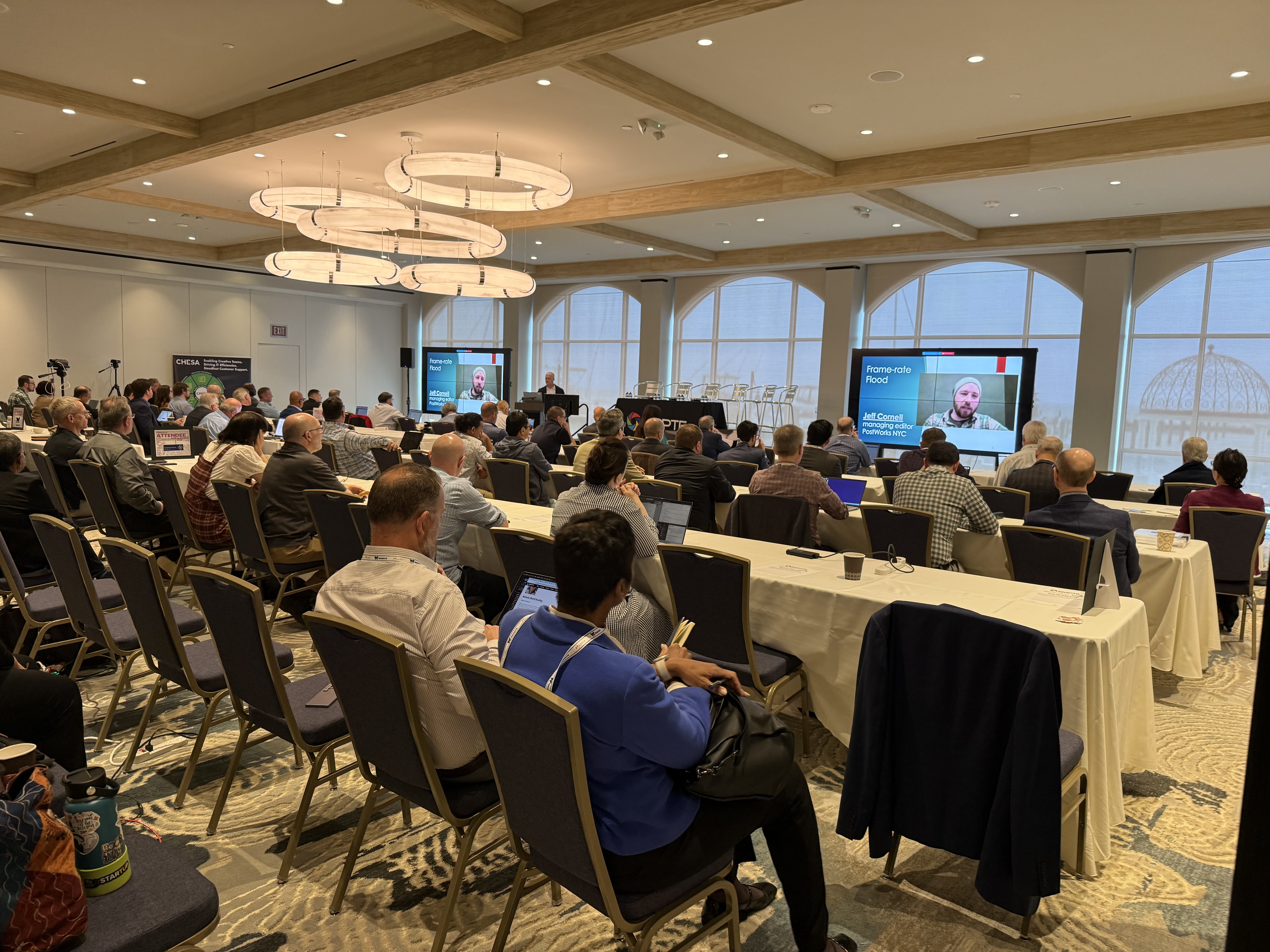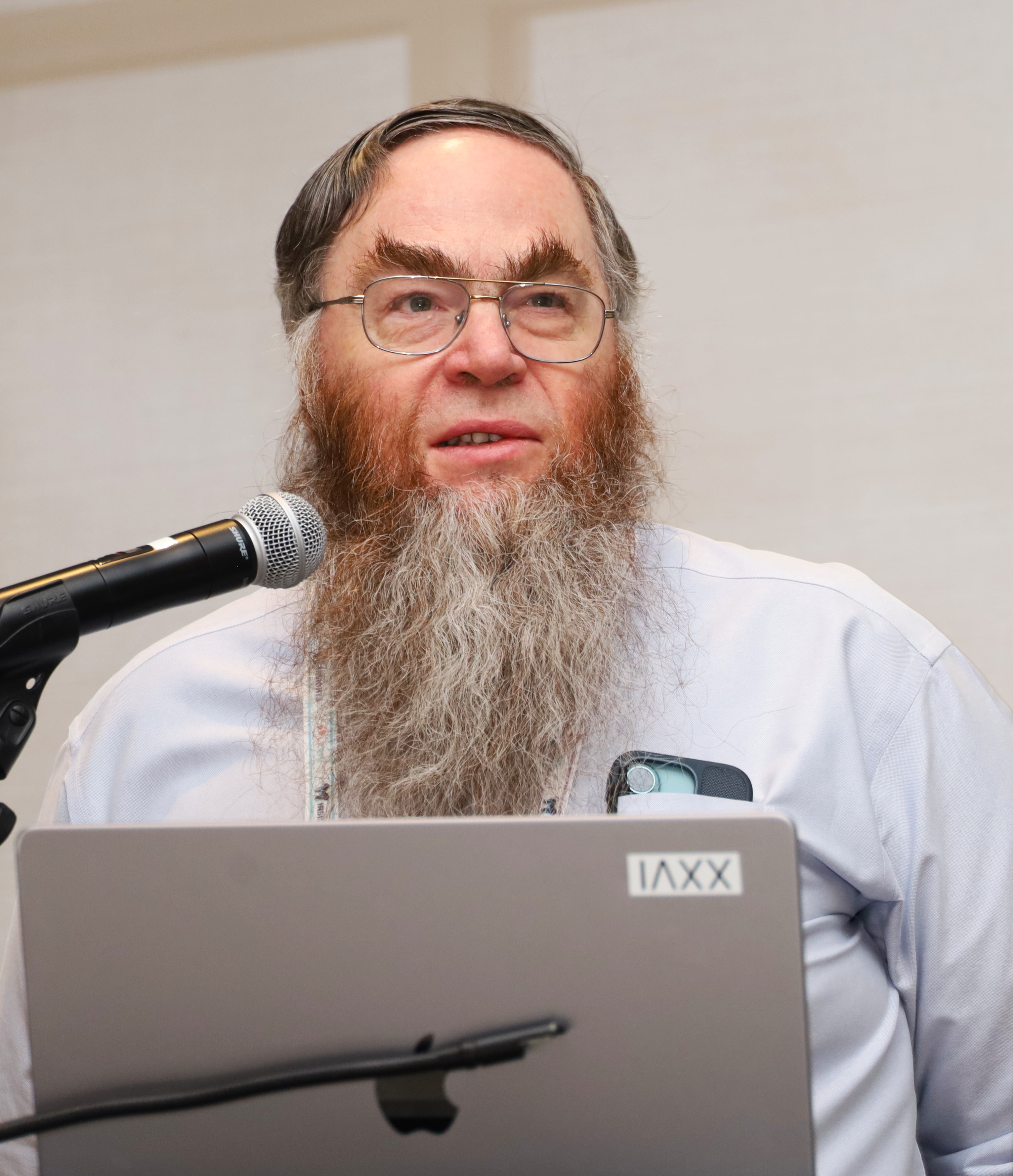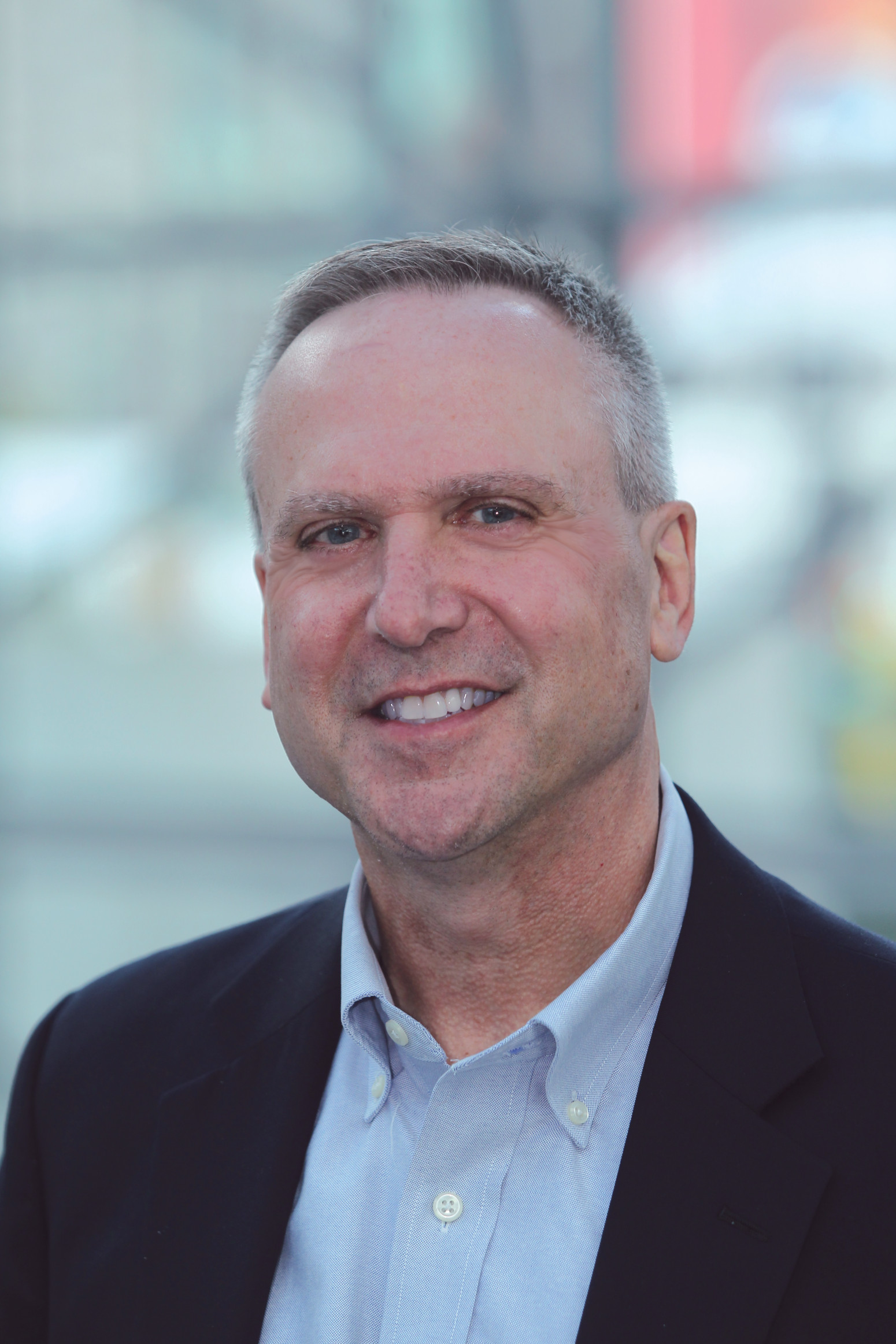SMPTE's Bits By the Bay Tackles AI's Impact on Media's Future
How will media companies cope with the challenges and take advantage of the opportunities?

Artificial intelligence, and its implications for the film and TV industry, were among the main topics of discussion at the SMPTE DC Chapter’s “Bits by the Bay” conference held in Chesapeake Beach, Maryland, from May 21-22.
The conference—organized by the late Peter Wharton, former chief strategy officer for TAG Video Systems—returned after a long hiatus, and the event is dedicated to his memory.
Rounding Up
In a presentation devoted to fractional film frame rates, James Snyder, formerly with the Library of Congress’ National Audio Visual Conservation Center (NAVCC) and now an industry consultant, discussed the evolution of frame rates in tandem with the development of film and television and the expectation that with the film industry transitioning to digital, that frame rates can be modified to address the streaming market.

The battle waged over interlace vs. progressive image standards during the transition from analog to DTV several decades ago illustrated the coming battles between broadcasters—most of whom favored interlace—and the computer industry, who favored progressive.
In a world where 24 fps in traditional film is really 23.98 frames per second (fps) for TV and digital video, and 60 fps is technically 59.94 fps, Snyder said it’s time to round up to the next number (an even integer) because advances in technology have made fractionals less relevant in today’s media distribution ecosystem.
As streaming and gaming have taken hold over the past several decades, progressive has won that battle, and streamers simply don’t care about frame rates, Snyder added.
“Interlace and fractional are two sides of the same coin—they're both problems we need to get rid of,” he said. “[Interlace is] the easiest to get rid of right now, because all displays are now natively progressive; we have no CRTs anymore and progressive is baked into our technical distribution now, or at least the end viewing. And frankly, getting rid of fractional is also baked into it.”
The professional video industry's #1 source for news, trends and product and tech information. Sign up below.
Snyder blamed the current U.S. broadcast TV standard.
“The only reason we can't do even integer right now is because ATSC 1.0 is in the way; ATSC 3.0 can accommodate it, the displays can accommodate it,” he said. “Every vendor I've talked to who has equipment that does production or post production can switch to even integer. The only thing that's standing in the way right now seems to be ATSC. 1.0 is a technical blocker.”
Snyder said he came to this conclusion in his work at the Library of Congress, where he worked in film digitization and restoration. Adherence to global media standards and the demands of storing and managing millions of hours of film and video content prompted him to think of new ways to approach the problems of cost and efficiency.
Streaming doesn't care what your framework is. Your computer just adjusts it to present the content.”
James Snyder
“We had to deal with the problems of interlace, we had to deal with the problems of fractional frame rates, and we had to deal with the technical issues that came with creating new versions for reuse, because people could license the content, and they would ask for various versions,” Snyder said. “And so I got to see firsthand the extra cost. And the reality is, there are increased costs just in producing new content, there are increased production costs when it comes to reusing old content.
“And so that's where a number of us got together and asked ourselves, ‘do we really need to be doing this?,’” Snyder added. “A genuine technical reason why we're still doing this, and the only one we can come up with is ATSC 1.0. If you take ATSC 1.0 out of the mix, ATSC 3.0 doesn't have that problem, and streaming certainly doesn't have that problem. Streaming doesn't care what your framework is. Your computer just adjusts it to present the content.”
Snyder added that this approach needs to be modified when considering live broadcasts.
“The one area that still needs some discussion and some work is, ‘how do you go from live feeds that are fractional to live feeds that are integer?’ We do need to talk about that. There are converters out there that do the work we can do… but they have a strange cadence to them. We need to figure out how to not have that strange cadence, and work it out in the software and the hardware.”
AI and Democratization of Media
John Footen, managing director with Deloitte, discussed the democratization of media production over the past four decades and how AI is impacting its future, pointing out that for as little as $500, today’s mobile device can produce professional content that cost thousands of dollars to produce in the 1980s. (Footen also pens TV Tech’s Media Matrix column.)
“You don't even have to have an education to do it, people are just doing it … and that's an overall trend of democratization in content production and distribution,“ he said. “Are we done democratizing media? Is it all democratized out? The answer is no.”

The ability for the average Joe to produce Disney-level content powered by AI is coming sooner than we thank, Footen added.
“That level of production is going to be theoretically possible for good or for bad, it's going to happen,” he said. “And it’s going to further democratize the content types that can be created by anyone. You don't have to be good at using a camera because you don't have to touch a camera to make an image, right? You don't have to get a lot of training and framing and all that stuff, because a machine will frame it for you.”
Footen elaborated on agentic AI, the concept of using AI “agents” to do specific tasks that could eventually replace the “app” environment of today.
“You can think of it interchangeably with the word 'apps' that you've been using today,” he said. “An agent is a system … it could be a simple system or it can be a complex system that performs a function. It actually does something like you would expect out of many kinds of applications.”
As these agents become more adept at each individual’s media tastes, this trend will lead to a breakdown of brands that still act as a sort of “walled garden.”
“A curator agent is an agent that works on your behalf to get your content for you today,” Footen said. Using the Plex video playback app as an example, Footen said the more information a user adds to it, the more intelligent it gets, the less important the origination.
“All you need to add to that is keeping track of who you are and what your preferences are, and giving it access to your data and giving it this AI capability to curate for your content,” he said. “Eventually, that curation disintermediates the media company, because why do I care what channel it's on, what app it's on… if it's just coming to you through my agent, my agent is my app. I don't care where the content came from.”
Content Validation
Matt Galek, Footen’s colleague at Deloitte, discussed the issue of authenticated content in the age of AI, elaborating on the latest developments around the Content Authenticity Initiative (CAI), a six-year-old project designed to to promote transparency and authenticity in digital content; and the C2PA, a consortium of tech companies tasked with developing the technical standards for content credentials, among other things.
C2PA is the “leading standard” to confirming and maintaining trust in digital content and is on the path to becoming an ISO standard this year, according to Galek, who pointed to the three pillars of technology that drive the standards developed by the CAI: metadata, fingerprinting and watermarking.
“All these together provide a solid foundation for authenticity,” Galek said.
While C2PA’s standards don’t deal with detection of AI-altered media, it starts with the assumption that most of it is now, Galek said. “C2PA kind of assumes that users are going to be changing a piece of media, and [in] some of the research I was looking at, most studies were saying that over 50% of people posting content to social media platforms have manipulated in some way, whether it's due to editing that content or adding a filter,” he said. “So that's a significant amount that has been altered in some way, and kind of unknowingly, you're consuming that media.”
Galek pointed to the importance of metadata in tracking a piece of content’s evolution through the complete production chain and how that vital information is getting lost when content migrates to various platforms. Adopting C2PA will help protect that information, he added.
“There's a ton of tech that’s used today where metadata gets stripped inherently out when media is transferred from one system to another,” he said. “For vendors adopting this standard, you will have that methodology to retain that metadata through an entire supply chain.”
Working groups with the C2PA are focused on areas like audio and video watermarking, but Galek said there has to be intra-industry cooperation.
“There needs to be an additional spotlight on the implementation side of things, to provide a forum for broadcast-based and other industries to collaborate,” he said. “We know how increasingly fragmented the broadcast vendor landscape is, so it’s that much more critical for us to collaborate together around content authenticity.”
Detecting Deep Fakes
Anyone who has dabbled in generative AI knows how better it is getting with time but altering video and images (aka “deep fakes”) has been done for decades, something Ed Grogan, a motion imagery researcher and former Defense Department official, discussed during the session “The Dark Side of AI.”

(Grogan discussed his work in video forensics with TV Tech in 2018).
“When we started this, it took a little Hollywood studio to really make good deep fakes, and they couldn't do much,” Grogan said. “We’re now at the point that some of these levels where that little Hollywood studio was are [now] being done by middle schoolers.”
Using a historic picture of Winston Churchill, Franklin Roosevelt and Josef Stalin at the Yalta conference in 1945—with Groucho Marx in place of the Soviet dictator—Grogan emphasized the importance of spotting discrepancies as early as possible, since a widely distributed AI-altered image could rapidly alter public perception. In other words, it could allow a lie to travel halfway around the world before the truth has its boots on, a line often attributed to Churchill himself.
“If you think it's fake, put it in your documentation, because someone 20 years from now might lose the reference material,” he said. “And if you don't say you think it’s fake and the audience didn’t have the historical reference, they might not know that really should've been Stalin and that’s the wrong Marx. So sometimes, because they don’t have the historical understanding, you can get something past somebody to tell your story.”
Although no one sees media companies losing their gatekeeper status anytime soon, Footen summarized the promise and perils of AI in removing media companies as the “middleman” for content consumption.
“If everyone can do what we're doing today, I think our industry is going to be disintermediated,” Footen concluded. “I'm not sure how much of a media industry we have left when everyone is a media company. Every person, every company, is a media company. Our job, historically, has been to create the content, to gather the audiences and to monetize that content. But what if we’re not needed to do that? That’s kind of happening already.”
Tom has covered the broadcast technology market for the past 25 years, including three years handling member communications for the National Association of Broadcasters followed by a year as editor of Video Technology News and DTV Business executive newsletters for Phillips Publishing. In 1999 he launched digitalbroadcasting.com for internet B2B portal Verticalnet. He is also a charter member of the CTA's Academy of Digital TV Pioneers. Since 2001, he has been editor-in-chief of TV Tech (www.tvtech.com), the leading source of news and information on broadcast and related media technology and is a frequent contributor and moderator to the brand’s Tech Leadership events.

